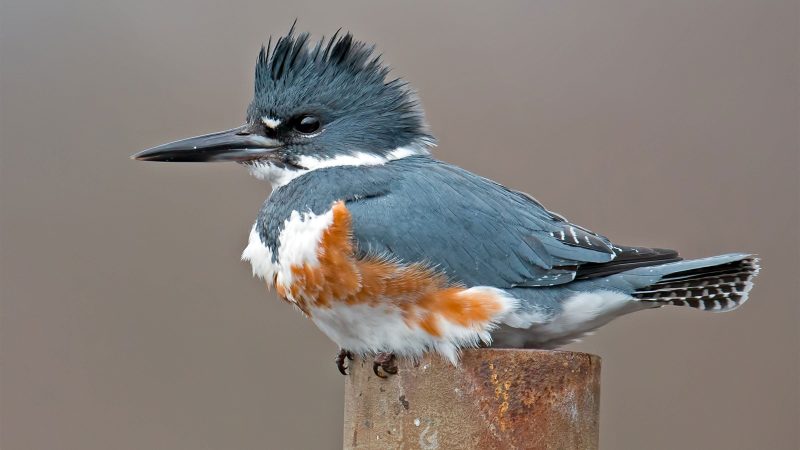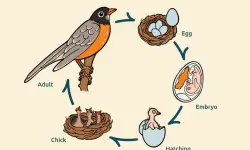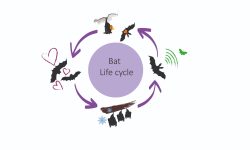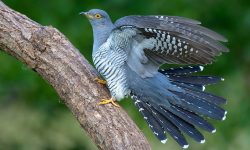With its rattling call, shaggy crest, and dive-bombing hunting style, the Belted Kingfisher (Megaceryle alcyon) is one of the most distinctive birds found near Ohio’s rivers, lakes, and wetlands. Though several species of kingfishers exist around the world, this striking bird is the only native and common kingfisher species in Ohio, thriving in aquatic habitats across the state.

Appearance and Identification
A Bold Silhouette on the Water
Few birds cut a sharper figure against the backdrop of Ohio’s waterways than the Belted Kingfisher (Megaceryle alcyon). Perched motionless on a low-hanging branch or hovering briefly above a stream, it is instantly recognizable thanks to its disproportionately large head, prominent shaggy crest, and heavy, dagger-like bill—an adaptation perfectly suited for spearing slippery prey.
The bird’s plumage features striking contrasts. Its slate-blue back, head, and wings blend seamlessly with the sky and water, while a clean white collar and underparts flash into view during flight. Across the upper breast runs a broad blue band, giving the species its “belted” name. Unusually in the avian world, the female is more vividly marked than the male, sporting an additional rusty chestnut band across the lower belly. This reverse sexual dimorphism is rare among birds and adds to the female’s visual allure during pair bonding.
The kingfisher’s sturdy legs and short tail reinforce its silhouette: compact, purposeful, and built for power—not speed.
Flight and Sound
In motion, the Belted Kingfisher exhibits a direct, mechanical flight, interspersing rapid wingbeats with short glides on stiff, shallow wings. Its movement hugs the contour of rivers and lakeshores, often tracing a straight path just above the water’s surface. The flight is typically low and purposeful—designed for efficiency and control, especially when diving for fish.
But often, you’ll hear the kingfisher before you see it. Its voice—a sharp, dry rattle or chatter—resonates across the water with a staccato rhythm that cuts through wind and wave. This call serves both as a territorial warning and an auditory flag for humans who recognize it as the signature sound of a kingfisher on patrol. In quieter settings, such as wooded creeks or still ponds, the sound may echo dramatically, adding a wild edge to the landscape.
Whether seen as a swift blue flash over a stream or heard in echoing bursts across a quiet lake, the Belted Kingfisher commands attention. Its combination of visual contrast, specialized form, and unmistakable voice makes it one of Ohio’s most iconic waterbirds.
Habitat in Ohio
Rivers, Lakes, and Stream Banks
In Ohio, the Belted Kingfisher finds its perfect niche in the state’s extensive network of freshwater ecosystems. From slow-moving creeks in rural woodlands to the wave-swept shores of Lake Erie, this species is a familiar presence wherever clear, fish-rich waters intersect with natural or semi-natural banks. Its preferred haunts include rivers, streams, ponds, marshy reservoirs, and gravel-lined lakeshores, particularly those bordered by sparse vegetation that offers unobstructed fishing perches.
One key feature defines the kingfisher’s relationship with its environment: steep earthen banks. These vertical or sloping walls of exposed soil—often found along eroding riversides, road cuts, or sand pits—serve as critical nesting habitat. During the breeding season, the kingfisher excavates horizontal burrows, often three to eight feet long, directly into these banks. Using its feet and powerful bill, it chisels out a nesting chamber far from the reach of ground predators, where it will lay and incubate its eggs.
This demand for both water clarity and nesting substrate makes the Belted Kingfisher something of a habitat specialist—one that thrives best in relatively undisturbed aquatic corridors. In more urbanized areas, it may still be seen in parkland waterways or quarry ponds, provided human activity doesn’t disrupt its feeding or nesting cycles.
Seasonal Movements
The Belted Kingfisher is considered a partial migrant in Ohio. While some individuals, especially in the southern half of the state, may remain throughout the year, many birds migrate southward during winter as freezing temperatures seal off their access to aquatic prey. Frozen rivers and ice-covered lakes make foraging nearly impossible, prompting a retreat to ice-free regions across the southeastern United States and coastal areas.
By early spring, as ice thaws and waterways reopen, these kingfishers return north, their rattling calls once again echoing along creeks and riversides. Spring and summer mark the height of kingfisher activity in Ohio—when territorial pairs defend feeding zones, dig nesting burrows, and raise their broods along quiet, fish-laden banks.
This seasonal ebb and flow of kingfisher presence reflects not only the changing conditions of Ohio’s climate but also the species’ remarkable mobility and adaptability. Where water runs clean and the banks rise steep, the Belted Kingfisher finds both sanctuary and sustenance—staking out its domain as the state’s solitary fishing sentinel.
Feeding Behavior
Masters of the Plunge Dive
The Belted Kingfisher is one of nature’s most skilled aerial anglers, perfectly adapted for life on the hunt above water. As a visual predator, it relies on keen eyesight and surgical precision to locate, target, and capture its prey—most often in the form of small, silvery fish flashing just beneath the water’s surface.
Perched motionless on a low-hanging branch or snag overhanging a stream, the kingfisher watches patiently, its body tense, eyes locked. When a target is spotted, it springs into action—sometimes by diving directly from the perch, other times by hovering midair like a hummingbird, wings buzzing rapidly as it adjusts for wind and water distortion. With a sudden, dagger-like thrust, it plunges headfirst into the water in a splash of feathers and precision, often resurfacing with a wriggling prize clamped tightly in its powerful bill.
What’s on the Menu?
The Belted Kingfisher’s diet is dominated by small fish, including minnows, sunfish, perch, and other shallow-water species found in Ohio’s lakes and rivers. But this bird is no dietary minimalist. When fish are scarce or conditions demand flexibility, it readily takes crustaceans, aquatic insects, amphibians like tadpoles and frogs, and even small reptiles or hatchling turtles. Its opportunistic appetite makes it a versatile forager, capable of thriving in a range of aquatic habitats.
The Finishing Move
Catching the prey is only half the job. Once the kingfisher returns to a perch—often the same one it launched from—it executes a finishing ritual. The bird strikes the captured fish repeatedly against the branch, stunning or killing it outright and softening the body for easier swallowing. It then tilts its head back and swallows the prey headfirst, a method that ensures that spines, fins, and scales don’t catch in its throat on the way down.
After feeding, it may pause to shake its feathers dry or emit a rattling call, then resume its patient vigil over the water. Day after day, dive after dive, the Belted Kingfisher sustains itself through a blend of strategy, strength, and instinctive mastery of the aquatic hunt.
Breeding and Nesting
Digging Tunnels into the Earth
The Belted Kingfisher doesn’t just hunt with precision—it nests with purpose. When spring returns to Ohio and waterways thaw, this solitary bird begins its brief but intense breeding season, which typically starts in late April to early May. Unlike many songbirds that build nests among branches, the kingfisher chooses a far more secretive and elaborate approach: it excavates its nest deep into the earth itself.
Once a monogamous pair has formed, the birds select a suitable vertical or near-vertical earthen bank—often along a river, stream, lakefront, or even man-made sites like gravel pits and road cuts near water. Using their sturdy bills as picks and their feet as shovels, they work tirelessly to dig a long, gently ascending tunnel, which can range from 3 to 8 feet (1 to 2.5 meters) in length. This gradual incline helps drain water during heavy rains, preventing the nest chamber from flooding.
At the tunnel’s end lies a spacious nesting chamber, unlined but smoothed by the birds’ movements. Here, the female lays a clutch of 5 to 8 glossy white eggs. Both male and female share the duties of incubation, which lasts approximately 22 to 24 days, and continue their cooperative parenting by feeding and guarding the hatchlings until they fledge.
A Fortress Beneath the Soil
The subterranean nature of the nest offers several evolutionary advantages. Hidden deep within the bank, the eggs and chicks are well-protected from most terrestrial predators such as raccoons, snakes, and skunks. The earthen walls also provide a stable microclimate, shielding the young from temperature extremes and maintaining consistent humidity crucial for egg development.
After hatching, the nestlings grow rapidly on a steady diet of regurgitated fish delivered by both parents. By about four weeks of age, the young are ready to leave the tunnel and begin practicing their first hovering flights along the same banks where they were born.
This nesting strategy—part engineering feat, part evolutionary marvel—reflects the kingfisher’s fierce independence and resourceful nature. Few birds go to such literal lengths to raise their young, and fewer still do it with such precision, power, and persistence.
Role in the Ecosystem
Guardians of Healthy Waters
The Belted Kingfisher is more than a solitary fisher and riverside sentinel—it is a living barometer of ecological well-being. Its continued presence along Ohio’s rivers, streams, and lakeshores signals not just biological diversity, but clean water, functional food chains, and intact natural habitats. In this sense, the Belted Kingfisher acts as an indicator species—a bird whose survival and behavior reflect the health of the ecosystem around it.
Because kingfishers are visual hunters, they depend heavily on clear water to detect and track prey. If a stream becomes clouded by sediment runoff, choked with algae, or tainted by pollutants, the kingfisher’s ability to hunt declines sharply. Its absence from a waterway can serve as an early warning sign of declining water quality, urban encroachment, or chemical contamination—issues that may go unnoticed until larger ecological damage occurs.
Natural Population Managers
As mid-level predators, Belted Kingfishers help maintain balance in aquatic food webs. By feeding primarily on small fish and aquatic invertebrates, they play a subtle but vital role in regulating prey populations, especially those that might otherwise experience unchecked growth. Their selective pressure often favors faster, more evasive fish, subtly shaping the behavior and composition of fish communities over time.
The kingfisher’s prey also serves to recycle nutrients, and when adults feed their young repeatedly throughout the day, they redistribute energy from aquatic environments to riparian zones—linking the two realms in a quiet but essential ecological exchange.
A Keystone of Biodiversity Awareness
Beyond their biological function, Belted Kingfishers also serve as ambassadors of biodiversity. Their bold presence, dramatic dives, and unmistakable calls draw the attention of birdwatchers, conservationists, and curious passersby. In this way, they help foster public engagement with aquatic ecosystems, encouraging protection of wetlands, rivers, and clean water initiatives that benefit countless species—including humans.
To preserve the presence of the Belted Kingfisher is to preserve the integrity of Ohio’s freshwater habitats, where wildlife, people, and ecosystems intersect in delicate, interdependent balance.
Conservation Status in Ohio
Common Yet Vulnerable to Change
In the present day, the Belted Kingfisher remains a widespread and fairly common species throughout Ohio, visible along rivers, reservoirs, and lakes from spring through fall. However, its relative abundance should not be mistaken for resilience. This bird, so closely tied to water quality and undisturbed shorelines, is increasingly at risk from subtle but accumulating human pressures.
The most significant threat to kingfisher populations is the loss and degradation of nesting habitat. As development encroaches on natural waterways, the steep, erodible banks required for burrow excavation are often replaced by hardened shorelines, riprap, or manicured embankments that offer no suitable substrate. Simultaneously, pollution from agricultural runoff, sedimentation, and urban waste can cloud the waters they depend on for hunting, impairing visibility and reducing prey availability.
Even where waterways remain, the increased use of pesticides and herbicides may indirectly affect kingfishers by reducing populations of aquatic insects and small vertebrates, disrupting the food web from the bottom up. Additionally, human disturbance during the breeding season—such as off-trail hiking or recreational boating near nest sites—can lead to abandonment of burrows and failure of nesting attempts.
Strategies for Conservation
While not currently listed as threatened or endangered in Ohio, the long-term outlook for the Belted Kingfisher depends heavily on our commitment to preserving natural riparian habitats. Effective conservation strategies include:
-
Protecting river corridors through land easements, park creation, and buffer zones.
-
Allowing natural erosion to maintain vertical banks for nesting.
-
Restoring native vegetation along shorelines to reduce runoff and stabilize stream banks.
-
Reducing chemical use near waterways to maintain water clarity and aquatic biodiversity.
Public awareness also plays a role. Encouraging local communities to recognize and value the Belted Kingfisher as a symbol of freshwater health can inspire broader efforts to protect the rivers, lakes, and wetlands on which it depends.
In the end, safeguarding this bird means safeguarding the waters it calls home—and by extension, the ecological integrity of Ohio’s most precious natural systems.
Fascination and Symbolism
A Favorite Among Birders and Beyond
Few birds stir the imagination like the Belted Kingfisher. With its shaggy crest, sharp silhouette, rattling cry, and fearless dives, this bird has earned a special place not only in the hearts of birdwatchers, but also in the broader tapestry of human culture and nature lore. For naturalists and casual observers alike, the sight of a kingfisher perched solemnly above a still stream evokes a sense of quiet precision—of wildness held in balance.
Among birders, the Belted Kingfisher is a coveted sighting. Its habit of patrolling shorelines and calling loudly makes it easier to detect than many elusive waterbirds, but its fast flight and sudden dives challenge observers to stay sharp. It is, in many ways, a bird that demands and rewards attention—mirroring the same qualities it embodies in myth and metaphor.
Symbols of Patience, Timing, and Peace
Across cultures, kingfishers are symbols of calm waters, clarity, and the power of waiting. In ancient Greek mythology, the kingfisher was associated with Halcyone, whose transformation into a bird by the gods gave rise to the term halcyon days—a period of peace and calm, particularly during winter solstice. This idea still lingers today in poetry and nature writing, where the kingfisher often represents tranquility after turmoil, or clarity in moments of stillness.
In Native American traditions, the kingfisher is sometimes seen as a guardian of water—a being of agility and sharp instinct, reminding observers of the importance of being fully present before taking action. Its quiet watchfulness, followed by sudden, decisive movement, embodies focus, precision, and timing—lessons echoed in both spiritual teachings and the patient art of birdwatching.
In modern conservation culture, the kingfisher has come to symbolize the fragile beauty of aquatic ecosystems, standing as a totem for those who work to protect rivers, wetlands, and the species that depend on them.
Whether as an emblem of peace or a sentinel of the stream, the Belted Kingfisher continues to captivate. Its presence reminds us not only of the richness of Ohio’s wild waters but also of the deep and enduring connection between birds, landscapes, and the human spirit.
Conclusion
The Belted Kingfisher stands alone in Ohio—a solitary representative of a vibrant bird family known for their fishing prowess and unusual nesting habits. With its striking looks, acrobatic hunting, and adaptability to Ohio’s riverbanks, this bird remains a brilliant part of the state’s natural heritage. By preserving its habitats and protecting water quality, Ohioans can ensure that the kingfisher’s rattling call and flash of blue continue to grace the waterways for generations to come.






